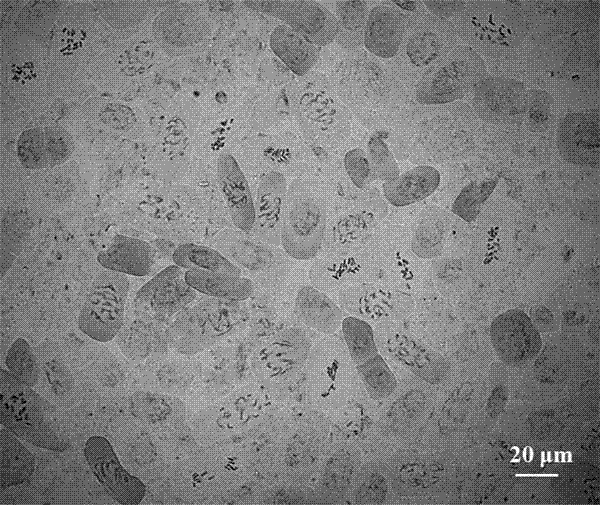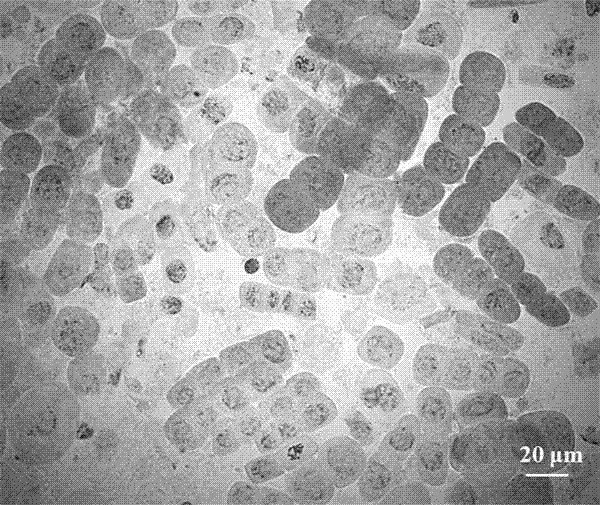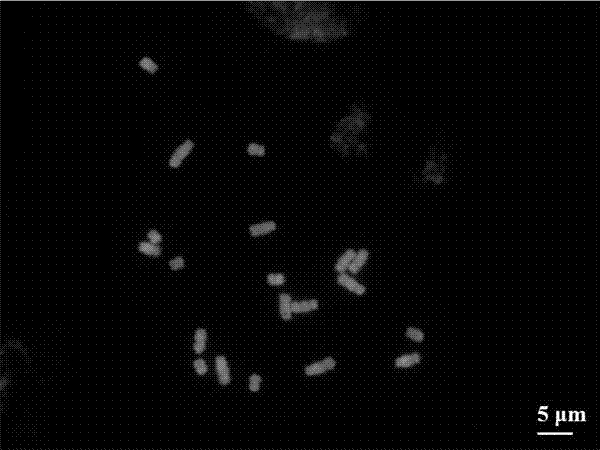Method for preparing asparagus root tip cell chromosome metaphase split-phase specimen
A technology of chromosomes and rhizoma rhizoma, applied in the field of plant cytogenetics, can solve problems such as unfavorable research and analysis, easy tailing of chromosomes, bad shape, etc., and achieve the effect of reducing the risk of pollution and poisoning, clear background, and good shape.
- Summary
- Abstract
- Description
- Claims
- Application Information
AI Technical Summary
Problems solved by technology
Method used
Image
Examples
Embodiment 1
[0031] A method for inducing the mitotic synchronization of root tip cells of Lithophora chinensis, comprising the following steps:
[0032] 1. Root tip culture: Soak the seeds of Cypress cypress in 30°C water for 24 hours, then put the seeds in a petri dish with 2-3 layers of filter paper soaked in water, and then cultivate them at 25°C for 4 days until the root length is 1cm;
[0033] 2. Hydroxyurea treatment: Treat cypress seeds with a root length of 1 cm with hydroxyurea at a molar concentration of 2.5 mmol / L at 25°C for 18 hours;
[0034] 3. Recovery culture: remove hydroxyurea, wash the seeds three times with clean water, and then cultivate the seeds in clean water at 25°C for 5 hours;
[0035] 4. N 2 O pretreatment: cut the root tip and put it into N 2 Treated in O gas chamber for 2h, the N 2 The pressure in the O gas chamber is 10atm (1.01MPa);
[0036] 5. Hypotonicity: Treat with KCl solution with a molar concentration of 0.075mol / L for 60 minutes;
[0037] 6. F...
Embodiment 2
[0042] Preparation of Metaphase Chromosome Specimens of Phyllostachys spp.
[0043] The apical meristem area of the synchronously treated Rhizoma cypress root was excised, placed in 20 µL of a mixture containing 1% pectinase and 2% cellulase, and incubated at 37°C. Solution 2h. After enzymatic hydrolysis, add TE buffer and pipette repeatedly to remove the outer layer of the root cap and root tip, then wash the root tip twice with 70% ethanol by volume, mash the root tip with a dissecting needle in 40 μL of ethanol, and vortex Suspend the cells, centrifuge to retain the precipitate, add 30 μL of anhydrous acetic acid, mix well, suck 5-8 μL droplet, and place it at room temperature for 5 minutes before microscopic examination. Films with good microscopic examination are placed in the ultraviolet cross-linking instrument through 120-125mJ / cm 2 Treat for 2 minutes to fix the chromosomes for later use. Microscopic examination results such as image 3 It can be seen that the c...
Embodiment 3
[0045]Fluorescence in situ hybridization of metaphase chromosomes
[0046] 45S probe labeling: Add the following components to a centrifuge tube on ice: corn 45S rDNA 2µg, 10×nicktranslation buffer 2µL, Labeled-dNTP (Texas red-dCTP or Alexa Fluor-488-dUTP) 0.5µL, Non-labeled -dNTPs 2µL, DNA polymerase I 5µL, DNaseI 0.5µL, make up to 20µL with deionized water. After mixing, treat in a PCR instrument at 15°C for 2 hours, add 5×TAE+140ng / µL salmon sperm DNA 175µL, add volume fraction 90% ethanol-volume fraction 10% sodium acetate 500µL, mix well to precipitate the probe for more than 2 hours, and then set Centrifuge in a centrifuge at 13000rpm for 30min, wash with absolute ethanol twice, store at room temperature in the dark for 30min, add 2×SSC 1×TE 20µL to dissolve the precipitate.
[0047] Fluorescence in situ hybridization: Prepare probe solution: add 0.5 µL of labeled probe to 5.5 µL of 2×SSC 1×TE, drop the probe solution onto the cells on the glass slide, and gently place ...
PUM
 Login to View More
Login to View More Abstract
Description
Claims
Application Information
 Login to View More
Login to View More - R&D
- Intellectual Property
- Life Sciences
- Materials
- Tech Scout
- Unparalleled Data Quality
- Higher Quality Content
- 60% Fewer Hallucinations
Browse by: Latest US Patents, China's latest patents, Technical Efficacy Thesaurus, Application Domain, Technology Topic, Popular Technical Reports.
© 2025 PatSnap. All rights reserved.Legal|Privacy policy|Modern Slavery Act Transparency Statement|Sitemap|About US| Contact US: help@patsnap.com



